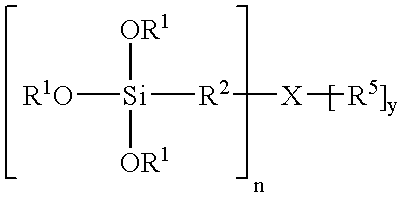Silane coatings for bonding rubber to metals
a technology of silane and metals, applied in electrophoretic coatings, transportation and packaging, organic chemistry, etc., can solve the problems of reducing the strength of metals, affecting the quality of metals, and most metals are susceptible to corrosion, so as to improve corrosion resistance and/or polymer adhesion
- Summary
- Abstract
- Description
- Claims
- Application Information
AI Technical Summary
Benefits of technology
Problems solved by technology
Method used
Image
Examples
example 1
[0081]The following table provides adhesion results using hydrolyzed silane solutions on cold rolled steel (“CRS”). For each of the silane solutions, the indicated concentration (by volume) of the silane was mixed with alcohol (methanol or ethanol) and an amount of water equivalent to the silane concentration. For example, a 5% A1170 solution was prepared by mixing 5% A1170, 5% water and 90% ethanol (by volume). The pH was adjusted to the indicated amount by adding acetic acid as needed. The silane solution was stirred for at least 24 hours in order to complete 10 hydrolysis. For mixtures of A1170 and A1289, the silanes were separately hydrolyzed in the same manner (5% silane, 5% water and 90% alcohol). After at least 24 hours of hydrolysis, the two silane solutions were mixed together to provide the indicated ratio of A1170:A1289, with the total silane concentration in the mixed silane solutions being 5% in all cases.
[0082]CRS panels were ultrasonically cleaned in acetone, hexane a...
example 2
[0086]Panels of electrogalvanized steel (“EGS”) were tested in the same manner as in Example 1, and the results are provided below.
[0087]
RubberFailureSilane, Conc.pHcompoundInstronmodeA1170, 5%8.5Compound 20 N100% InterfaceA1289, 5%6.5Compound 2120 ± 30 N100% InterfaceA1170:A1289 = 3:16.9Compound 2121 ± 61 N100% InterfaceA1170:A1289 = 1:16.9Compound 2 91 ± 13 N100% InterfaceA1170:A1289 = 1:37.1Compound 2 72 ± 35 N100% Interface
[0088]As noted from the above table, the addition of hydrolyzed A1170 to hydrolyzed A1289 solutions does not significantly affect adhesion performance, even though hydrolyzed A1170 by itself provides no adhesion. However, the addition of A1170 during the period of time will provide greater corrosion protection, particularly during metal shipment or storage between application of the silane coating and rubber bonding.
example 3
[0089]Panels of tin-coated CRS were tested in the same manner as in Example 1, and the results are provided below.
[0090]
RubberFailureSilane, Conc.pHcompoundInstronmodeA1170:A1289 = 1:34.25Compound 1227 ± 18 N100% InterfaceA1170:A1289 = 1:94.4 Compound 1173 ± 44 N100% InterfaceA1170:A1289 =4.38Compound 1164 ± 4 N100% Interface1:19
Unhydrolyzed Silanes
[0091]In the next set of examples, unhydrolyzed silane compositions were employed. Unless otherwise noted, all of the silane coatings were applied from pure silanes (either pure A1170, or a mixture consisting only of A1170 and A1289 in the indicated ratio). After the silanes were mixed with one another, the resultant silane mixture was wiped onto the metal (which had been cleaned in the manner described previously) using a paper towel. Unless otherwise noted, the silane coating applied in this manner was then dried for one hour at 150° C. Thereafter, the rubber composition was bonded to the silane coated metal in the manner described prev...
PUM
| Property | Measurement | Unit |
|---|---|---|
| Temperature | aaaaa | aaaaa |
| Temperature | aaaaa | aaaaa |
| Temperature | aaaaa | aaaaa |
Abstract
Description
Claims
Application Information
 Login to View More
Login to View More - R&D
- Intellectual Property
- Life Sciences
- Materials
- Tech Scout
- Unparalleled Data Quality
- Higher Quality Content
- 60% Fewer Hallucinations
Browse by: Latest US Patents, China's latest patents, Technical Efficacy Thesaurus, Application Domain, Technology Topic, Popular Technical Reports.
© 2025 PatSnap. All rights reserved.Legal|Privacy policy|Modern Slavery Act Transparency Statement|Sitemap|About US| Contact US: help@patsnap.com



